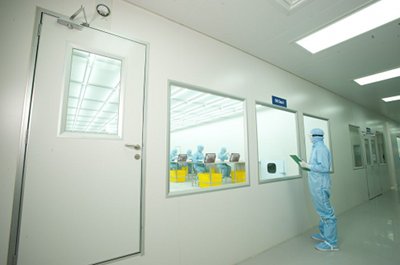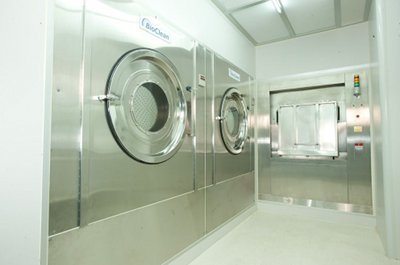Manufacturer and supplier of cleanroom consumables and garments, Nitritex has just launched a cleanroom laundry service. Richard Bryant, group sales director, outlines the major considerations for those looking for a laundry partner
As every cleanroom operator is aware, among the most important facets of cleanroom management are ensuring the prevention of contamination and the provision of sufficient comfortable clothing to ensure that operations can continue uninterrupted.
Contamination – considered anything that has an effect on quality or performance of the products being manufactured or processed – can take the form of particulates, bio-pollutants, chemical cross-contamination or even electrostatic discharges (ESD), which individually or collectively have a detrimental effect on product or process performance.
The contaminants concerned are normally invisible to the human eye and can be as small as 0.1 micrometres (µm), which makes their control and elimination a huge challenge. A key to that control is an understanding of where the particles come from. Up to 80% of all particulates are the human detritus that is shed by the operatives working in the cleanroom.
Each of us sheds our outer layer of skin every week in the form of loose particles (about 4–5µm) or groups of cells (typically 25–30µm). Once present in the environment these particles are broken up and ground down by human activity or other mechanical abrasion into the very fine dust particles that are so easily dispersed into the atmosphere. As these particles are human derivatives there is a high probability that some will contain chemicals and bio-residues, such as bacteria.
No amount of scrubbing and cleaning can prevent cleanroom operatives from shedding particulates, so it is impossible to eliminate their source. This means that we have to accept that containment of these particulates is essential to prevent them from being released into the cleanroom environment. The key to this control is the use of high-specification cleanroom clothing.
When deciding on the management of cleanroom clothing the cleanroom operator has three options to choose from: single use disposable garments; reusable launderable garments; or a combination of the two. The influencing factors are: the garment system required to achieve the desired level of containment; the number of changes of garb required by each operative per day; the number of occasional visitors into the controlled area; and the level of support and service provided by the cleanroom laundry.
As a rule of thumb, once the number of garment changes per week reaches 20, the best strategy for the cleanroom operator is to opt for reusable launderable garments, using an independent cleanroom laundry to supply, maintain, clean, pack and manage the necessary garment stock.
Garments
Typically, the following factors will need to be considered when choosing the type of garments that are appropriate for use in the cleanroom:
- The class of cleanroom – the higher the classification, the greater the need for full body coverage. For instance, in ISO Class 51, or European GMP2 Grade A or B cleanrooms it is essential to wear coveralls, hoods, boots, facemasks and gloves.
- Type of cleanroom – in sterile environments fabric that is resistant to multiple sterilisation cycles must be used in the manufacture of the garments.
- Static electricity – this causes a variety of problems in cleanrooms. The spark from an electrostatic discharge can damage products (e.g. in electronic component manufacture) or can start a conflagration in explosive atmospheres. Just as house dust is attracted by and sticks to the television screen because of static electricity, so cleanroom particulates and bacteria are attracted to cleanroom garments that hold a static charge. For these reasons it is important that garments are made from material that is static dissipative with a surface resistance that is typically in the range of 106–108 Ohms.
- Garment changes – cleanrooms that require 20 garment changes per week should be looking to use reusable launderable garments.
- Compatibility – it is important that the garments integrate seamlessly with other items such as gloves, masks and footwear.
- Visitors – if there is a large number of visitors to the cleanroom on a regular basis and launderable garments are in use then holding a small stock in a range of common sizes is the best option. If the number of visitors is minimal disposable garments are probably the most economic option.
Garment construction
If the purpose of launderable garments is to contain contamination from the wearer then the garments themselves must not be a source of particulates. The construction of the garments and the materials used must ensure that this goal is achieved. There must be no raw fabric edges in evidence anywhere in the garment, so all seams should be of either French, bound or lapped construction. As well as containing the particulates from the material edges these seam construction methods prevent the free passage of air (and hence contamination) from the inside of the garment into the cleanroom.
At the planning stage it is vital to consider any additional features, such as pen loops and studded cuffs, that will affect the overall performance of the garments. Features, such as pockets, pleats and additional seams, should be avoided as they create entrapment areas for unwanted contamination.
The fabrics used must be non-linting (usually close woven polyester), comfortable to wear and anti static (or more correctly, static dissipative). Antistatic fabrics are usually recognisable by a grid or stripe pattern that is woven into the cloth using electrically conductive thread. The garments should also be carefully designed so that they are comfortable to wear when donned correctly, giving operatives no reasons for not fastening collars and cuffs correctly.
There are two methods of testing garments for particulate emission. The first uses a Helmke Drum3, where the garments are put into a rotating stainless steel drum and an airborne particle counter measures the number of particles over 0.3µm/ft3.
In the second,4 air samples are drawn through a filter on certain parts of the garment to determine the quantity of particles and fibres in and on the garment.
When deciding on both garment design and fabrics, consideration should be given to the anticipated processing that the garments will encounter during their lifecycle. Beyond laundering, these are primarily sterilisation processes, such as irradiation or autoclaving, which will have a detrimental effect on garment lifespan.
Allowance should also be made for wearers carrying out tasks exposed to greater wear or staining. Their garments should be ring-fenced from stock in general circulation to avoid cross-contamination and deterioration of the stock.
Selecting a laundry
The ideal cleanroom laundry will have the capability to provide a complete and integrated service from the identification of garment needs through to the availability of ready to wear stock at the cleanroom site. It will build its support structure around the client’s requirements rather than the other way round. The ideal laundry will have the infrastructure, procedures, flexibility and understanding to ensure that clients can forget about their garment needs once a contract has been signed.

Laundries should be built and maintained as ISO Class 5 cleanrooms
The cleanroom laundry must itself be built and maintained as an ISO Class 5 cleanroom using ultra-pure deionised water to wash the garments, with line clearances and planned cleandowns between batches. The line clearances are used before garments are moved from one area to another to avoid any possibility of garment mix up.
In addition, cleandowns involve the swabbing down of surfaces and areas to prevent contamination. Regular particulate monitoring must be carried out in the laundry and independent audits of the room and water supplies should be conducted frequently.

Cleandowns should involve the swabbing of surfaces and areas
Garment identification and tracking is essential to ensure receipt and delivery reconciliation. This provides a cradle to grave history of each item in circulation as well as management information relating to garment usage and other key data to help the partner to adapt to changes in requirements.
Logistics and garment replacement are key elements of the overall service. If items are not collected and delivered as per the agreed schedule or deliveries are short, it severely impacts the seamless operations of the cleanroom.
Finally, there is the issue of overall customer service. This can be construed as a myriad of different elements. Clear service goals and metrics should be documented as part of a Service Level Agreement (SLA) so that both supplier and customer have a clear understanding of how the contract will operate throughout its term. As part of the SLA it is important for supplier and client to be clear how and when garments are to be repaired in terms of quality and appearance. For example, some companies have frequent client visitors to the cleanroom and do not want garments with patches undermining their corporate image.
Each party must have a clear understanding of the point at which it becomes uneconomic and unrealistic to repair a garment and have it replaced. No garments should be inserted into circulation without prior consent from the customer. The supplier’s reputation, industry knowledge and experience in the cleanroom environment provide additional security for any cleanroom operator seeking a new laundry provider.
Proper management of cleanroom garments and ensuring that users adhere to the correct protocols are essential to ensure garment life is maximised and wastage reduced. Detailed reports on garment lifecycle, repairs and user compliance should be available to provide information for efficient cleanroom operation.
Broad service options
In summary, to maintain cleanroom operational efficiency, it is vital that the correct garments are selected based on the points discussed, the garments are cleaned and maintained to the highest possible controlled manner and that there is good integration between the garments and consumables, such as gloves and masks.
The broad range of garment requirements and service options means that contracts can become complex. It is, therefore, important that the cleanroom laundry is flexible in its approach, giving options to cleanroom operators that suit their needs, and this should include options such as:
- Full service – all-inclusive package
- Split rental – separate charges for garments and laundry processing
- Process and maintain – charged per item
- Lease to own – no residual charges at the end of contract.
Nitritex is well established within the controlled environment industry, therefore customers can be assured that they will receive the same exacting quality standards from its newly launched service – The Cleanroom Laundry. The company’s technical expertise and proven garment range give added confidence that it can provide a turnkey service from garment manufacture, implementation, laundry processing and on-going support.
References
1. ISO 14644-1: 1999, Cleanrooms and associated controlled environments. Classification of air cleanliness, International Standards Organisation
2. Rules and Guidance for Pharmaceutical Manufacturers and Distributors, Medicines and Healthcare products Regulatory Agency
3. IEST-RP-CC003.3, Garment Systems Considerations for Cleanrooms and Other Controlled Environments, Institute of Environmental Sciences and Technology
4. ASTM F51-00 (2007), Standard Test Method for Sizing and Counting Particulate Contaminant In and On Clean Room

